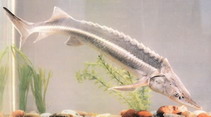| Family: |
Acipenseridae (Sturgeons), subfamily: Acipenserinae |
| Max. size: |
211 cm TL (male/unsexed); max.weight: 80 kg |
| Environment: |
demersal; freshwater; brackish; marine; depth range 30 - 60 m, anadromous |
| Distribution: |
Europe: Black, Azov, Caspian and Aral Sea, ascending some rivers (Danube up to Bratislava, Volga up to Kazan, Ural up to Chkalov), unknown or very rare in others. On the verge of extinction in its natural range.
Extirpated in Aral basin; nearly extirpated in Black Sea basin; only occasional records from Danube and lower Volga; only a very small population remaining in Rivers Ural (Russia, Kazakhstan) and Rioni (Georgia); no natural spawning population in Iran; established in Lake Balkhash where it forms a large population (Ref. 59043). Artificially propagated (Ref. 6866). |
| Diagnosis: |
Dorsal spines (total): 0-0; Dorsal soft rays (total): 45-57; Anal soft rays: 23-37. Snout moderately long and pointed at tip. Lower lip continuous, not interrupted at centre. Barbels halfway between tip of snout and mouth, reaching the latter. Five rows of scutes, dorsal 11-17, lateral 49-70, but usually 55-56 on each side, ventral 10-16, with no smaller plates between dorsal and ventral rows. Color of back grey, flanks lighter, belly white. |
| Biology: |
Adults occur in the sea close to shores and estuaries and in deep stretches of large rivers over muddy substrate. Are usually solitary. Juveniles live in shallow riverine habitats (Ref. 59043). Feed on mollusks, amphipods and chironomid larvae. Spawning takes place in strong-current habitats in main course of large and deep rivers on stone or gravel bottom (Ref. 59043) from end of April to June (end of May in Rioni River, Black Sea) (Ref. 3193). |
| IUCN Red List Status: |
Critically Endangered (CR); Date assessed: 14 September 2019 (A2cde) Ref. (130435)
|
| Threat to humans: |
harmless |
Source and more info: www.fishbase.org. For personal, classroom, and other internal use only. Not for publication.

